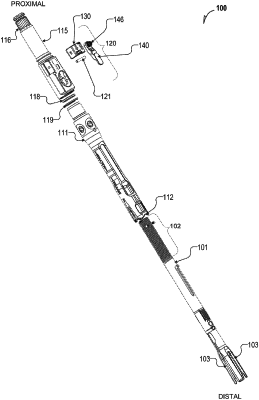| CPC A61B 17/7086 (2013.01) [A61B 17/7091 (2013.01); A61B 90/03 (2016.02); A61B 2017/00407 (2013.01)] | 19 Claims |

|
16. A rod reduction instrument comprising:
an inner shaft including a threaded proximal portion and a distal end, the distal end including a plurality of engagement members adapted to receive a housing of a pedicle screw;
an outer housing slidably received over at least a portion of the inner shaft, the outer housing including a top sleeve and a bottom sleeve, the bottom sleeve including a distal end adapted to engage a connecting rod; and
a ratchet mechanism disposed along the top sleeve of the outer housing, the ratchet mechanism including an engagement feature to selectively engage the threaded proximal portion of the inner shaft, the ratchet mechanism including a non-inner shaft-engaging button lock disposed on an external surface of the ratchet mechanism, the non-inner shaft-engaging button lock including a first unlocked position and a second locked position to selectively lock the engagement feature of the ratchet mechanism against the threaded proximal portion of the inner shaft,
wherein the non-inner shaft-engaging button lock is a stepped shaft disposed transverse to a longitudinal axis of the rod reduction instrument and translatable between the first unlocked position and the second locked position.
|